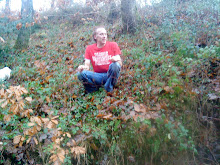Collecting Blackthorns in the Dart Valley
Today I am looking over the reforesting areas around the edge of the moor, for Blackthorns, to thicken up the hedges I am planting at the moment.
As Blackthorns grow, they send out long underground rhizomes, from which new trees, in the form of suckers grow around the basses of the parent plants.
This natural form of vegetative propagation, provides me with many little trees to dig up, without diminishing the local population. As is it always my code of practise to only ever take baby trees, which I feel have 0% chance of reaching maturity, in their current location.


Digging Blackthorns up
 Most baby blackthorns are suckers, from a mother plant. Occasionally I find seed grown ones, but usually not. The thing to be most aware of is the Rhizomes; These under ground propagational roots, seem to grow in virtually straight lines, radiating out from the mother plants, a few inches under the soil surface.
Most baby blackthorns are suckers, from a mother plant. Occasionally I find seed grown ones, but usually not. The thing to be most aware of is the Rhizomes; These under ground propagational roots, seem to grow in virtually straight lines, radiating out from the mother plants, a few inches under the soil surface. At intervals along these Rhizomes, of a foot (30cm), or so; sprout young Blackthorn trees. This gives me an idea where the rhizomes are, also gently tugging the young trees can show quite clearly their position. This then tells me where to cut, with the spade, in order to get the most root possible, with each little tree, that I take.
At intervals along these Rhizomes, of a foot (30cm), or so; sprout young Blackthorn trees. This gives me an idea where the rhizomes are, also gently tugging the young trees can show quite clearly their position. This then tells me where to cut, with the spade, in order to get the most root possible, with each little tree, that I take. I cut cleanly round each tree and make sure that the rhizome is cut both sides, then I gently pull up the root ball, shake off the soil and place them in a plastic sack containing some damp leaves or moss, to stop the roots from drying out.
I cut cleanly round each tree and make sure that the rhizome is cut both sides, then I gently pull up the root ball, shake off the soil and place them in a plastic sack containing some damp leaves or moss, to stop the roots from drying out.






















